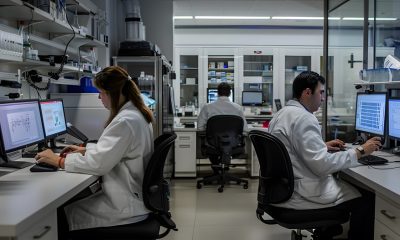News
Investigators discover a ‘double life’ for key Parkinson’s disease protein

One of the hallmarks of Parkinson’s disease is the accumulation in the brain of a protein known as alpha-synuclein.
For more than two decades, alpha-synuclein has been a focal point of attention for researchers, clinicians and drug makers interested in Parkinson’s disease. But alpha-synuclein’s function is not well understood.
A new study led by investigators at Brigham and Women’s Hospital, Harvard Stem Cell Institute and the Broad Institute of Harvard and MIT shines new light on the role of alpha-synuclein.
The research has uncovered a new function for the protein with relevance for Parkinson’s disease and related conditions. Findings were published in scientific journal Cell.
Elusive
“Our study offers new insights into a protein that is known to be at the center of the development of Parkinson’s disease and related disorders,” said corresponding author Vikram Khurana.
Khurana is chief of the Division of Movement Disorders within the Department of Neurology at the Brigham and Harvard Medical School, and a principal investigator within the Ann Romney Center for Neurologic Diseases at the Brigham.
“This is a protein that is being targeted by current therapeutics, but its function has been elusive,” he said.
“Traditionally, alpha-synuclein has been thought to play a role in binding to the cell membrane and transporting structures known as vesicles. But our study suggests alpha-synuclein is leading a double life.”
P-body
Khurana and colleagues’ initial leads came from yeast and fruit fly models of alpha-synuclein toxicity and were substantiated through studies of human cells, patient-derived neurons and human genetics.
The team found that the very same part of the alpha-synuclein protein that interacts with vesicles also binds to ‘P-body’ structures, machinery in the cell that regulates the expression of genes through messenger RNAs (mRNAs).
In induced pluripotent stem cell-derived neurons generated from Parkinson’s disease patients with alpha-synuclein gene mutations, the physiologic structure and function of the P-body was lost, and mRNAs were abnormally regulated.
The same occurred in tissue samples from postmortem brains from patients.
Human genetic analyses supported the disease-relevance of these findings: patients who accumulate mutations in P-body genes appeared to be at higher risk for Parkinson’s disease.
The authors describe alpha-synuclein as a ‘toggle switch’ that regulates two very distinct functions: transport of vesicles and gene expression. In disease states, the balance is broken.
Treatments
The findings have potential implications for development of treatments for Parkinson’s disease.
The authors note that more clarity is needed on which of the P-body machinery components might be the best targets for a therapeutic intervention.
Ongoing genetic studies aim to identify which patients might be best suited for such an intervention, and how much this newly discovered pathway contributes to risk of the disease and disease progression in Parkinson’s disease patients at large.
“If we want to be able to develop treatments that target alpha-synuclein, we need to understand what this protein does and the potential consequences of reducing its level or activity,” said lead author Erinc Hallacli, of the Department of Neurology and the Ann Romney Center for Neurologic Diseases at the Brigham.
“This paper provides important information to fill our knowledge gaps about this protein, which may be beneficial for clinical translation.”
News
Weight loss jabs my only temporarily reduce ‘food noise,’ study finds
News
Childhood loneliness linked to increased risk of dementia, study finds

Childhood loneliness increases the risk of dementia in later life, according to new research.
Adults who recalled being lonely and without a close friend in childhood faced a 41 per cent higher risk of developing dementia, even if they were no longer lonely as adults.
People who frequently felt lonely without close friends during youth showed accelerated cognitive decline — a worsening of memory and thinking — and started middle age with lower scores on these skills.
Researchers from universities in China, Australia and the US, including Harvard and Boston universities, analysed data from 13,592 Chinese adults tracked from June 2011 to December 2018.
The critical factor was the subjective feeling of loneliness itself. Those who reported often feeling lonely as children had a 51 per cent higher dementia risk, even if some had close friends.
However, those who only lacked close friends but did not feel lonely showed no significant difference in risk.
Nearly half of roughly 1,400 adults in the study reported being lonely and without close friends during childhood.
The 4.2 per cent who experienced both faced the highest risk of cognitive decline.
The link to dementia remained strong even for people who were no longer lonely in adulthood, suggesting early-life isolation can have lasting effects on brain health.
During childhood, the brain develops rapidly and is vulnerable to harm. Loneliness acts as a chronic stressor, flooding the developing brain with harmful hormones that can damage memory centres, and it reduces stimulation from social play and peer interaction that helps build robust neural networks.
A separate 2024 study of more than 10,000 older adults found that specific childhood hardships — including poverty, disruptive home environments or parental addiction — were directly linked to poorer cognitive function later in life.
Youth loneliness appears to be rising, partly linked to widespread social media use.
Among girls, 64 per cent aged five to seven, 67 per cent aged eight to 10, and 73 per cent aged 11 to 13 reported feelings of loneliness last year. More than a quarter of boys aged 11 to 17 in the US report feeling lonely.
Children face growing social isolation, with one in four Americans now eating every meal alone — a rate that has surged by over 50 per cent since 2003. Sharing meals with friends and family helps build bonds and positive memories in youth.
Fewer children are playing outside or joining team sports.
A recent study reported that one in three children do not play outside on school days, and one in five do not do so even at weekends.
The 2024 research found a direct, dose-dependent relationship between childhood adversity and cognitive problems in adults — the greater the early trauma, the greater the later risk.
For each significant increase in early trauma, individuals faced an eight per cent higher risk of daily memory issues and scored lower on objective tests of mental speed and focus.
News
Don’t miss you essential monthly agetech update

Your essential monthly update on agetech’s progress
Welcome to your monthly snapshot of the facts, figures, opinions, trends and challenges shaping the development of agetech.
Our new monthly tracker report aims to provide an concise update for busy agetech professionals on the many factors influencing your work.
Here you will find a concise breakdown of deals, developments and opportunities from the last 30 days; and insight and opinion from leading thinkers in the field.
We hope you find something useful and/or inspiring below – and welcome any feedback about what else you’d like to see included.

 Independence1 month ago
Independence1 month agoNew US$6.5m centre targets healthy ageing

 Wellness2 weeks ago
Wellness2 weeks agoJust 3,000 steps a day may slow Alzheimer’s progression, study finds

 News2 months ago
News2 months agoSimple test can predict risk of severe liver disease

 News4 weeks ago
News4 weeks agoWeight loss drug reduces heart attack and stroke risk regardless of weight loss

 News7 days ago
News7 days agoDiabetes expert launches ‘world-first’ music-based health learning platform

 News1 month ago
News1 month agoWeight loss jabs could make cancer scans less effective, study suggests

 News3 weeks ago
News3 weeks agoRound up: US$25m fund to reimagine human longevity

 News2 months ago
News2 months agoExercise may lower dementia risk, study suggests




































